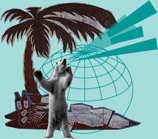NORDIC AMNESIA:
AN INTRODUCTION TO RETHINKING NORDIC COLONIALISM
by Kuratorisk Aktion (Frederikke Hansen & Tone Olaf Nielsen)1
The colonial history of the Nordic region is a dark chapter that seems to have slipped the memory of many of the Nordic populations. Although it continues to make itself very much felt in the region’s former colonies, this history is alarmingly absent in the collective memory of the once-colonizing Nordic countries.
With Rethinking Nordic Colonialism: A Postcolonial Exhibition Project in Five Acts, we aim to shed light over this history. Not only do we hope to explain why this past has been forgotten in some parts of the region. We also want to show how this history continues to structure the Nordic societies today, and how our contemporary problems of intolerance, xenophobia, and nationalism have their roots in this history.
Hopefully, the project will also demonstrate that the postcolonial state that the region finds itself in today is not only a story of oppression and sad destinies. The historical chain of cultural clashes between colonizers and colonized have resulted in other formations of modernity and other value systems different from those of the West. If we dare engaging them, they might pose fruitful alternatives to existing norms and values.
Rethinking Nordic Colonialism will revisit this history during the course of five acts, which combines exhibitions with workshops, conferences, hearings, and happenings in the locations of Iceland, Greenland, the Faroe Islands, and the Sámi area of Finland. 56 internationally recognized artists, theorists, politicians, and grassroots activists from all over the world participate in the project, which runs from March 24 – November 25, 2006.
The project opens in March in Reykjavik, Iceland (a former colony of Denmark) with an art exhibition and a workshop. In April, the project moves on to Nuuk, Greenland (also a former colony and now a self-governing part of the Kingdom of Denmark), where audiences are invited to attend a new art exhibition and a public hearing. Tórshavn in the Faroe Islands (also a former colony and now a self-governing part of the Kingdom of Denmark) will host Act 3 the following month, where yet another art exhibition is complemented by a performance event. Act 4 takes place in June in Rovaniemi in the Finnish part of Sápmi (the home land area of the indigenous Sámi people) and also features an art exhibition combined with a conference. In the fifth act, the many activities and conclusions of the project will be documented on a DVD and website, which are released on November 25, 2006 during four simultaneous closing events in the Nordic metropolises Copenhagen, Helsinki, Oslo, and Stockholm. With Act 5, the project’s many postcolonial voices reach the past colonizers of the Nordic region and become audible to their present populations – and to the world at large.
Rethinking Nordic Colonialism is remarkable in a number of ways. It represents a first attempt at writing a comprehensive history of Nordic colonialism and involves all the Nordic countries. It supports the incipient postcolonial studies in the Nordic region. And last, but not least, it is based on extraordinary partnerships between important art and culture institutions in the region: The Living Art Museum3 and The Reykjavik Academy in Iceland; Greenland National Museum and Archives as well as the Teachers’ Training School of Greenland in Nuuk; The Faroe Islands Art Museum and The Nordic House in Tórshavn; The Arctic Centre and Finnish Railways Locomotive Engine Shed in Rovaniemi in Northern Finland (Sápmi). We are forever grateful to all these institutions, to all the participants in the project, and to all the foundations and sponsors, who have supported the project financially. Without them, this project would not have been possible.
Notes
1. A big thank you to Hamayun Latif Butt, Richard William Hill, Anne Holmfred, and Sarat Maharaj for their input during the writing of this introduction.
2. The text in the fact boxes is freely quoted from Veli-Pekka Lehtola, The Sámi People: Traditions in Transition, Aanaar – Inari: Kustannus-Puntsi Publisher, 2004; Wikipedia. The Free Encyclopedia, and historian Nina Nørgaard, who has assisted us in researching the region’s colonial history.
3. The Living Art Museum does not host the exhibition in their own gallery spaces but in a space above the museum kindly sponsored by Stoðir hf.
